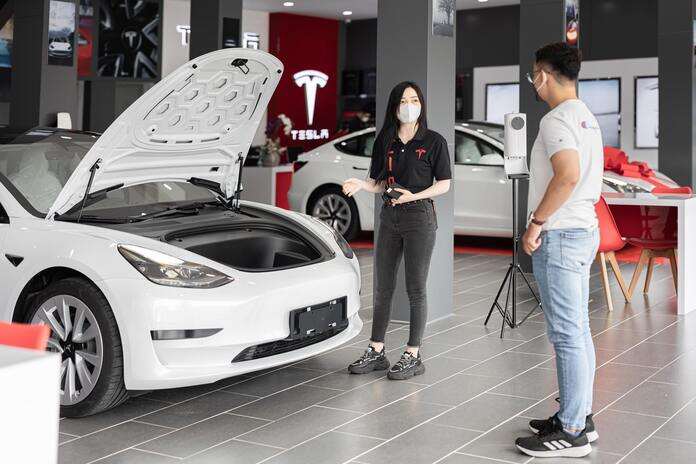Tesla Stock (NASDAQ:TSLA)
While using substantial subsidies to sell metal, Tesla’s record first-quarter vehicle sales belie rising fears that the company’s unsold vehicle inventory is taking on worrisome proportions.
In anticipation of this weekend’s news, shares, which gained more than 6% on Friday, are projected to open lower as investors are anticipated to realize profits on previous positive wagers.
Musk managed to boost global demand by cutting prices, but the number of deliveries increased by just 4.3% in the last three months of December. The concern is that the quest to set yet another record may cost it valuable margins.
Excess supply, as reported by Tesla, reached 13 days’ worth of sales at the pace of the previous quarter, a two-thirds rise over year-end and its greatest level since the third quarter of 2020 came to an end.
The level, according to independent analysts, is higher than the stated official amount.
Tesla built more cars in the previous 12 months than it delivered to customers—more than 78,000.
Tesla has transitioned away from prioritizing cars intended for export early in the quarter before focusing on domestic demand, according to Musk’s business, which has stated on multiple occasions that the gap is caused by an increase in “in transit” vehicles.
Tesla put the responsibility for the dismal Model S and X volumes in Q1 squarely on this problem, but the promises were met with skepticism.
The CEO of the hedge fund manager Gerber Kawasaki and a longstanding supporter of Tesla, Ross Gerber, stated, “Delivery numbers for X/S are a little worrying.” Despite price reductions, they appear to have lost high-end clients this quarter.
The disappointment with its meager Q1 sales rise sparked a ferocious battle for narrative dominance on social media.
Musk’s own Twitter defenders pushed Reuters to retract a headline stating that Q1 deliveries actually fell short of projections using his Community Notes feature (the news agency uses its own proprietary polling data from data partner Refinitiv that differed from those compiled by Bloomberg).
Tesla Receives Varying Ratings
Remember that the market evaluates Tesla’s development differently from that of other established automakers as a growth stock that strives for an average annual volume growth of 50%, a truly astounding amount in the manufacturing industry.
Investors, who are crucial in the evaluation process, should base their conclusions on Tesla’s improvement from one quarter to the next rather than the customary focus on year-over-year volume improvements, where Musk usually dazzles due to the expanding adoption of EVs.
And in this case, the 4.3% growth over Q4 is at best modest when taking into account with rising stocks and price reductions.
The Chinese Lunar New Year makes the first quarter typically sluggish, according to bulls, but sales were impeded since volume-boosting price cuts didn’t start boosting sales until mid-January.
But, there is very little room for disappointment when your stock is the ninth most valuable mega-cap in the world and is worth $650 billion, which is more than the following seven largest automakers put together.
While using substantial subsidies to sell metal, Tesla’s record first-quarter vehicle sales belie rising fears that the company’s unsold vehicle inventory is taking on worrisome proportions.
In anticipation of this weekend’s news, shares, which gained more than 6% on Friday, are projected to open lower as investors are anticipated to realize profits on previous positive wagers.
Musk managed to boost global demand by cutting prices, but the number of deliveries increased by just 4.3% in the last three months of December. The concern is that the quest to set yet another record may cost it valuable margins.
Excess supply, as reported by Tesla (NASDAQ:TSLA), reached 13 days’ worth of sales at the pace of the previous quarter, a two-thirds rise over year-end and its greatest level since the third quarter of 2020 came to an end.
The level, according to independent analysts, is higher than the stated official amount.
Tesla built more cars in the previous 12 months than it delivered to customers—more than 78,000.
Tesla has transitioned away from prioritizing cars intended for export early in the quarter before focusing on domestic demand, according to Musk’s business, which has stated on multiple occasions that the gap is caused by an increase in “in transit” vehicles.
Tesla put the responsibility for the dismal Model S and X volumes in Q1 squarely on this problem, but the promises were met with skepticism.
The CEO of the hedge fund manager Gerber Kawasaki and a longstanding supporter of Tesla, Ross Gerber, stated, “Delivery numbers for X/S are a little worrying.” Despite price reductions, they appear to have lost high-end clients this quarter.
The disappointment with its meager Q1 sales rise sparked a ferocious battle for narrative dominance on social media.
Musk’s own Twitter defenders pushed Reuters to retract a headline stating that Q1 deliveries actually fell short of projections using his Community Notes feature (the news agency uses its own proprietary polling data from data partner Refinitiv that differed from those compiled by Bloomberg).
To meet Musk’s annual target, delivery growth would need to accelerate, stated Gene Munster, managing partner at Deepwater Asset Management and a supporter of Tesla.
Cybervault Rumors Highlight the Desire for a New Product
With its current product lineup and current list pricing, Tesla is growing to the point where it finds it difficult to achieve its aspirational growth goals.
Recently, its two brand-new automobile factories in Texas and Germany set new weekly production records, and they are rapidly absorbing the local demand that its enormous factory in Shanghai once met.
In actuality, they are now vying for customers with Tesla’s wildly successful China operations.
It is therefore no accident that Tesla’s automotive gross margins, a frequently watched indicator of earnings power, reached their highest level of 32.9% in the first quarter of 2022, just before the two new sites started producing cars.
Because of its forecast that yearly sales will reach 20 million vehicles by 2030, Musk’s automaker is priced as a growth company, which is a worry.
The path to get there, though, defies belief: in order to realize his vision, the roughly 1.8 million cars targeted this year would have to increase to 5 million by 2026 and then quadruple in only four years.
No automaker has even come close to doing that, much less selling just 10 different models—half of which have already been introduced with the Model S, X, 3, and Y as well as the recently introduced Semi—under just one brand.
With commercial cars delivered to customers likely numbering in the dozens rather than hundreds, semi-production is too low for Tesla to even bother publicizing. The exact Cybertruck launch date for this year, as well as its exact technical specifications and price, are still unknown.
The desire for brand-new items to support its growth story was clear in the hysterical speculation around the “Cybervault,” which was hinted at last week, after last month’s unsatisfactory investor day and a successful coup by rival VW to steal Tesla’s thunder. It turned out to be only a new wall box for charging your Tesla when it was unveiled on Monday in China.
Featured Image: Pexels















